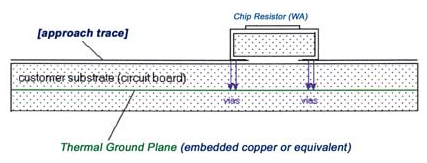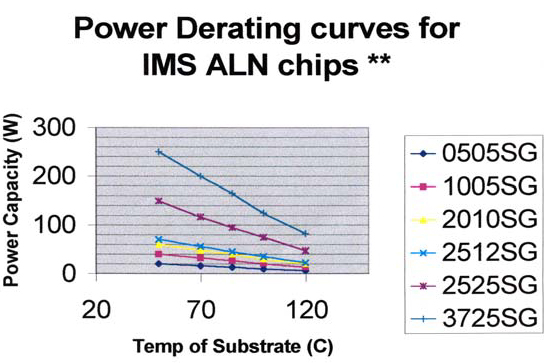Frequently, one needs more power in a chip of a given size. The question regarding IMS chip resistors then becomes whether or not to choose aluminum nitride (ALN) chips, or alumina (Al2O3) chips in the Super RCX family. In most cases, the answer depends on whether or not the power requirement is a couple of watts, or much more – e.g., 10-20W.
Before ALN is considered, however, we must first ask whether or not the customer is thermally managing the chips that need upgrading. If the answer is “yes” and 20
watts or more are needed in a small package, then ALN is the answer. If the customer is not thermally managing (or cannot), choosing ALN will not help, since ALN does not radiate heat any more readily than Al2O3. ALN is a much better conductor of heat than Al2O3, which makes it a great solution when a lot of power is needed and it also makes ALN a great alternative to BeO, especially when BeO is unacceptable for use, an ever more frequent occurrence.
ALN has a thermal conductivity (abbreviated: k) of about 170-180 W/meter°C, whereas Al2O3 has a k of about 25-28 W/meter°C. The value of k actually varies with the temperature of the material itself, but these values are adequate for discussion (BeO has a k of about 260 W/meter°C). This means that under identical conditions, ALN conducts heat approximately 6-7 times better than Al2O3.
In terms of thick film resistors, the advantage that ALN has over Al2O3 as a substrate is not realized unless the baseplate of the resistor is kept at a constant temperature, a technique otherwise described as providing an “infinite heat sink”, or keeping the base plate in a steady-state temperature condition. The lower the temperature, the more power the film can handle if the temperature of the film is kept below critical levels, which we have established at 150°C, when ambient air is 70°C in free air conditions.
If the resistor is mounted to a surface that does not conduct heat well, such as a different ceramic, FR-4, or another circuit board material, ALN’s advantage disappears. A sufficient and typical method by which most manufacturers provide a heat sink or thermal ground is shown in Figure 1.

Figure 1
Typical heat sinking application. The ground plane is kept at a constant temperature, an approach known as an “infinite heat sink”
The vias are metallic connections that provide a thermal connection between the chip baseplate (or pads) and the ground plane. Note that the ground plane cannot be electrically grounded unless the chip is an SG style; this applies to both ALN and Al2O3 equally. If any
Al2O3 resistor is mounted to a thermally managed surface
(e.g., a heat sink kept at a constant temperature), it will handle much more power than its free air rating suggests.
Here is an example. A standard IMS 2512 chip (Al2O3) is being used in a free air (non-thermally managed) application. Its free air rating is 1W, which means that the chip will handle 1W of power regardless of what surface it is mounted to, provided that surface does not attain a temperature greater than the aforementioned 150°C.

The curves in Figure 2 show power derate data for IMS Aluminum Nitride (ALN) chip resistors of SG style. Data points were taken on ANX series
chips* at substrate temperatures of 50, 70, 85,100 and 120 degrees C. The maximum allowable film temperature was 150°C. Thus, for each chip, the derated power goes to zero at a substrate temperature of 150°C.
The customer would like to get 10 watts out of the same real estate that he has available to him, in this case the area of the 2512 chip. Figure 2 (see reverse), the power derate curve, provides some guidance.
One can see that the customer has a few choices:
1. Replace the 2512 chip with an ALN 2512 chip, and maintain the temperature of the baseplate at a constant 120°C or cooler. This may be achieved with an arrangement similar to Figure 1. An even cooler temperature (cooler than 120°C) would allow the chip to dissipate even more than 10W; or,
2. Use an ALN chip of smaller size and keep the baseplate even cooler (e.g., the customer could use a 0505 chip if he kept the baseplate temperature at 50°C).
A third alternative would be for the customer to stick with a standard Al2O3 2512 chip providing that it is mounted to a thermally-managed surface, i.e., kept at a constant temperature. In this instance, for 10W, a 2512 chip will survive if the baseplate is kept at or below approximately 70°C.
Conversely, if the customer is already planning to upgrade his system to thermally manage the baseplate, which he had not done before, then the change to ALN may well be unnecessary unless he also wants or needs to reduce chip size or needs a significant amount of power.
Finally, the customer can also use a 2512S chip; it can handle 2W in free air and up to 14W if its baseplate is kept at or below 100°C. All of these numbers, incidentally, can be derived from Figure 2, by looking specifically at the 2512 curve (light blue line, third from the top). At about 100°C baseplate temperature, an ALN chip will handle just under 40W, which means a standard 2512 chip will handle about 6 times less (~6-7W), but a 2512S chip will handle twice that, or about 14W.
Clearly, it is easy to present ALN as an alternative to BeO, although it should be noted that its power handling, under equal conditions, is about 2/3 that of BeO (180/260). If the customer is already heat sinking his chips and needs much more power (or needs to significantly reduce real estate), then ALN is a great alternative to an Al2O3 chip.
If a customer does not need either of the above (i.e., needs to double or triple power handling, rather than increasing it by a factor of 10 or more), and is planning on thermally managing, then an alumina chip might be just fine. In fact, the chip that he is currently using may be fine, as we’ve noted above, depending on the degree of thermal management planned for the device.
Thus, IMS alumina chips are rated (power) under free air conditions, which means that alumina chips will handle much more power than what is reflected in the rating, but only if thermal management is applied.
A quick way of determining how an alumina chip will rate under thermal management conditions is to simply use the graph in Figure 2 to determine what an ALN chip will handle (picking appropriate temperatures from the curve for a given chip size) and then dividing by 6.
*Chips 1206 and smaller are 25 mil thick nominal, chips 2512 and larger are 40 mil thick nominal.
**For Alumina (Al2O3) chips, simply divide elements in graph by six, e.g., a 2512 sized alumina chip at 85°C would be rated at about 7W.
Download our tech note here.


